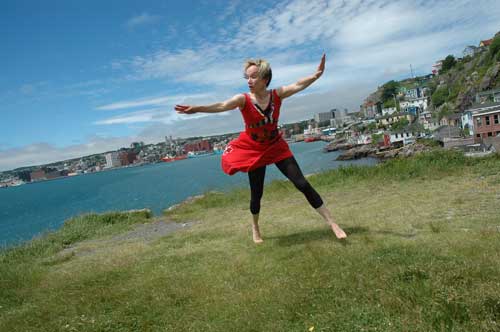Many people assumed it was a joke. In the wake of the #metoo and #timesup movements and the National Ballet of Canada coming under fire for their all-male 2018/19 choreographic lineup, promotional material for an upcoming evening of new works at a prominent ballet company talked about “the inexhaustible theme of what it is to be a woman” and referred to women as “one of culture’s most generous symbols.” The show would be an homage to women, titled Femmes, yet would not involve any female choreographers. What a brilliant satire to comment on the lack of female choreographic representation in the ballet world. Except Les Grands Ballets Canadiens wasn’t joking.
Femmes, which was renamed Parlami d’Amore after pressure from the community, was to feature three “distinct voices of European contemporary ballet” choreographing about the “subject of women” – Douglas Lee, Marwik Schmitt and Medhi Walerski. On March 6, Walerski removed himself from the project in solidarity with women in the dance world. Announcing his decision in a Facebook post, Walerski stated, “I cannot stress enough that female dancers and choreographers have been and still are one of the strongest pillars of my work. Yet, I am aware of the pervasive misrepresentation and lack of predominance they have been often subjected to in their own careers, and I do not stand for that.”
Parlami d’Amore is part of Les Grands Ballets Canadiens’ 62nd season, which was billed as “an ode to women.” The season title was updated to “Discovering Women” in an effort to address concerns from the dance community, but this language is no better. As Artistic Director Ivan Cavallari stated in the season announcement, “Our programme this year is designed to awaken powerful emotions. Its central theme is Woman: through Her, this season’s repertoire comes to life.” Out of the eight choreographers featured in the programme, only one is a woman: Cathy Marston, whose Lady Chatterly’s Lover will open the season.
Montréal-based flamenco dancer and choreographer Sylvie Marchand was shocked when she first heard about the season’s programming: “I thought, what the hell is going on? That’s great that it’s an homage to women, but where are the women?” Toronto-based choreographer and former National Ballet of Canada dancer Kathleen Rea had a similar reaction and decided to launch a petition on March 4: “Tell Les Grands Ballets to include female creators [and] use marketing language respectful of women.”
In only five days, Rea’s petition garnered almost 3,000 signatures and got the attention of Les Grands Ballets Artistic Director, Ivan Cavallari, who reached out to Rea. On March 13, they met and discussed gender equality, their shared vision of a successful and thriving ballet company, and what Les Grands Ballets could do to increase the number of female choreographers they present. Rea was happy that the company wanted to start a dialogue, but she said the tone of the meeting was somewhat defensive, with the company stating that they present more female choreographers than most. Rea finds that to be a low bar they have set for themselves.
During this controversy, few men spoke out apart from Walerski and Toronto-based choreographer Benjamin Kamino. In a letter he sent to the Board of Directors of Les Grands Ballets on International Women’s Day, Kamino outlined his discomfort with the way the Femmes program “seemed to actively uphold in plain sight, almost celebrating, the systemic sexism and misogyny deeply engrained in our field.” He urged the Board to take action and use their power and influence to end discrimination in all forms.
Rea recalls that when she danced with the National Ballet of Canada in the ’90s, out of approximately forty works she danced, only one was choreographed by a woman. The situation is slightly less abysmal these days. Looking at the 2018/2019 seasons of four of Canada’s largest classical ballet repertory companies (Les Grands Ballets Canadiens, National Ballet of Canada, Royal Winnipeg Ballet and Alberta Ballet), there are minimal female choreographed works among their programs: Les Grands, The National Ballet and Alberta Ballet each have one, while Royal Winnipeg has three (in two season offerings). Three out of the four companies are led by a male artistic director. It seems Les Grands Ballets is somewhat on par with their peers. It is also worth noting that Ballet BC, which focuses on more contemporary works, is led by artistic director Emily Molnar. The company has not yet announced its upcoming season.
Meanwhile, spin from ballet companies’ public relations promise audiences “female-centred” narratives, such as Royal Winnipeg Ballet’s upcoming season featuring “fearless female protagonists”: Offred in The Handmaid’s Tale, Juliet Capulet of Romeo & Juliet and Dorothy from The Wizard of Oz. And yes, this is important, but the tactic seems like a bandaid solution to the bigger gender problem in ballet: gender parity in top positions.
Outside of Canada, things don’t look much better. The Royal Ballet has three male resident choreographers, and their current season includes only one woman (Charlotte Edmonds). The spring 2018 season of American Ballet Theatre includes nine choreographers, two of whom are women, while the Paris Opera Ballet has a slightly better ratio with four women out of twenty-one choreographers in their upcoming season.
“In a female-dominated milieu like dance, we’re still having these conversations,” marvels Marchand. “What does that say about our society?” Women far outnumber men in the dance world, but they are underrepresented in choreographic and leadership positions. If they want to become a successful, internationally-known choreographer, they struggle to find enough work to do so. Many artists decide to create their own dance companies or become independent artists in order to be able to present their work and have more control over their careers. Perhaps this is what motivated artists such as Marie Chouinard, Margie Gillis or Karen Jamieson.
“It’s not just that [Les Grands Ballets] did this, but it’s about the history of inequality,” said Rea. Ballet has a long and troubled history of systemic male dominance and female acquiescence. As Deirdre Kelly describes in Ballerina: Sex, Scandal, and Suffering Behind the Symbol of Perfection, ballet began as a male-dominated art form. While women were eventually allowed on stage as performers, they were not considered for positions of power. In the early days of the art form in the 18th century, ballerinas were sponsored by wealthy men who would take them as mistresses. This systemic inequality has persisted to this day with most artistic directors, executive directors, and board members being men.
As Marchand and Rea both point out, the problem is perpetuated because a board of directors composed of mainly white males will tend to hire an artistic director who is a white male, who will in turn hire a majority of male choreographers. While it may not be purposeful, this “boys club” system makes it very difficult for women choreographers to succeed. “They’re totally missing the point,” said Marchand, explaining that the elitism of ballet companies will have to change if they are to remain relevant. Rea agrees that Millennial audiences will demand a greater awareness of social justice and diversity.
There is also the matter of artistic choice. Cavallari, during his meeting with Rea, cited artistic choice as his reason for proceeding with a third male choreographer to replace Walerski and stated that he plans to program a companion piece in an upcoming season featuring three female choreographers. This raises the question of whether, as an artistic director and curator of art, it is enough to cite artistic choice despite criticisms from the public. Sasha Kleinplatz, choreographer and dance curator with Wants and Needs Danse, believes that curators should be accountable to the community and that they have a duty to promote equity and diversity. “He somehow failed at the job I thought he was supposed to do,” she said.
Everyone makes mistakes, but it’s how we make it right that counts. While Rea would have liked to see a female choreographer take Walerski’s place, and perhaps this was a missed opportunity to make amends with the dance community, she is relieved that the inappropriate marketing language has been changed. “It was such a relief to see the name changed and not have women described as a symbol.” Marchand, on the other hand, is not appeased: “It’s a superficial change; it means nothing.” Kamino said in his letter that he feels anger and outrage.
Despite the traditional gender inequality in the ballet world, there are positive developments being made. In February of this year, Ballet Kelowna presented Elles: Extraordinary Dance Created by Women featuring four women choreographers. Artistic Director Simone Orlando is leading by example: “By supporting the artistic development of these female artists, we hope to inspire other companies to do the same,” she said in an interview with Kelowna’s Daily Courier. Kleinplatz sees hope in the programming being hosted by the Régroupement québecois de la danse (RQD), including a roundtable on sexual harassment in dance.
There is hope that the dialogue about gender imbalance in dance will continue. Cavallari shared with Rea that Les Grands Ballets plans to host a symposium and invite companies from all over North America to work together to find solutions. The first step is acknowledging that there is a problem, and there seems to be consensus that it exists. Rea cited a recent National Geographic issue, in which the magazine acknowledged that they had been racist in the past, as an example of how to respond tactfully to this type of sensitive issue without looking for praise, validation, or forgiveness. “That’s how you show up to the conversation,” said Rea. It’s likely that the symposium would address related diversity concerns, including race.
In the meantime, Rea has written an open letter to male choreographers that includes a list of actions they can take to support their female counterparts. She also sees mentorship as an important action that companies can take to nurture the careers of female dance artists, along with taking a chance on an unknown and presenting emerging female choreographers.
The conversation about diversity in the ballet world is just getting started, but in order to capture the hearts of contemporary audiences, the industry will have to set aside some of its traditional ways and embrace change.
Editor’s note: in a previous version of this article it was noted that Canada’s Royal Winnipeg Ballet’s upcoming season had only one female choreographer in their repertoire.
~
A little goes a long way. Donate to The Dance Current today to support bold and inclusive coverage of dance in Canada.






